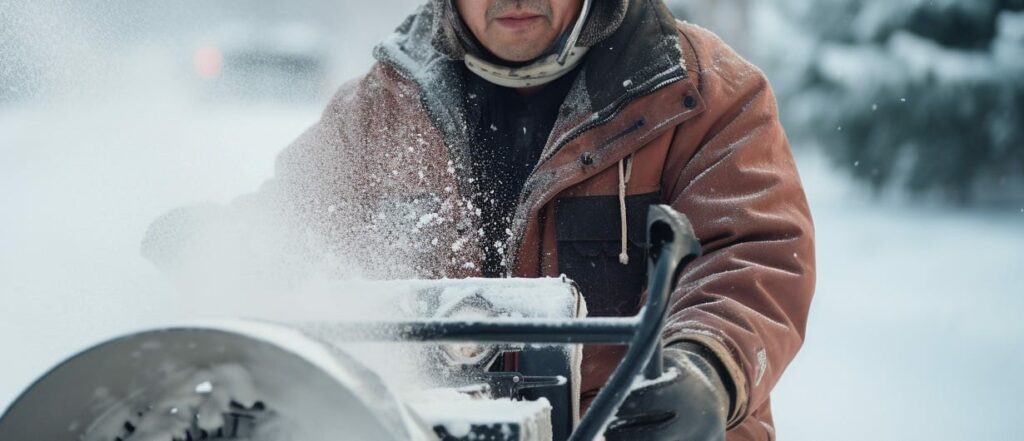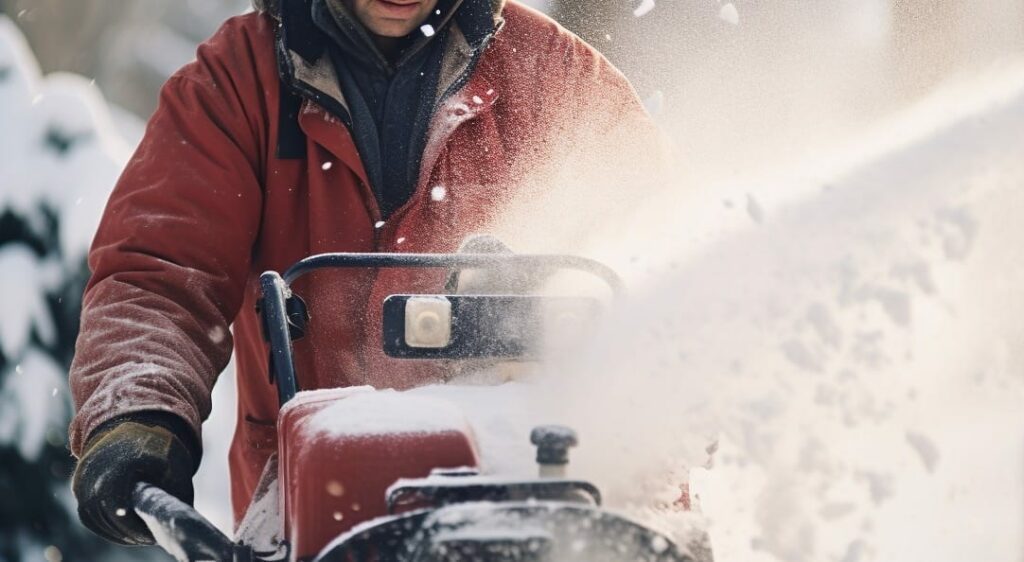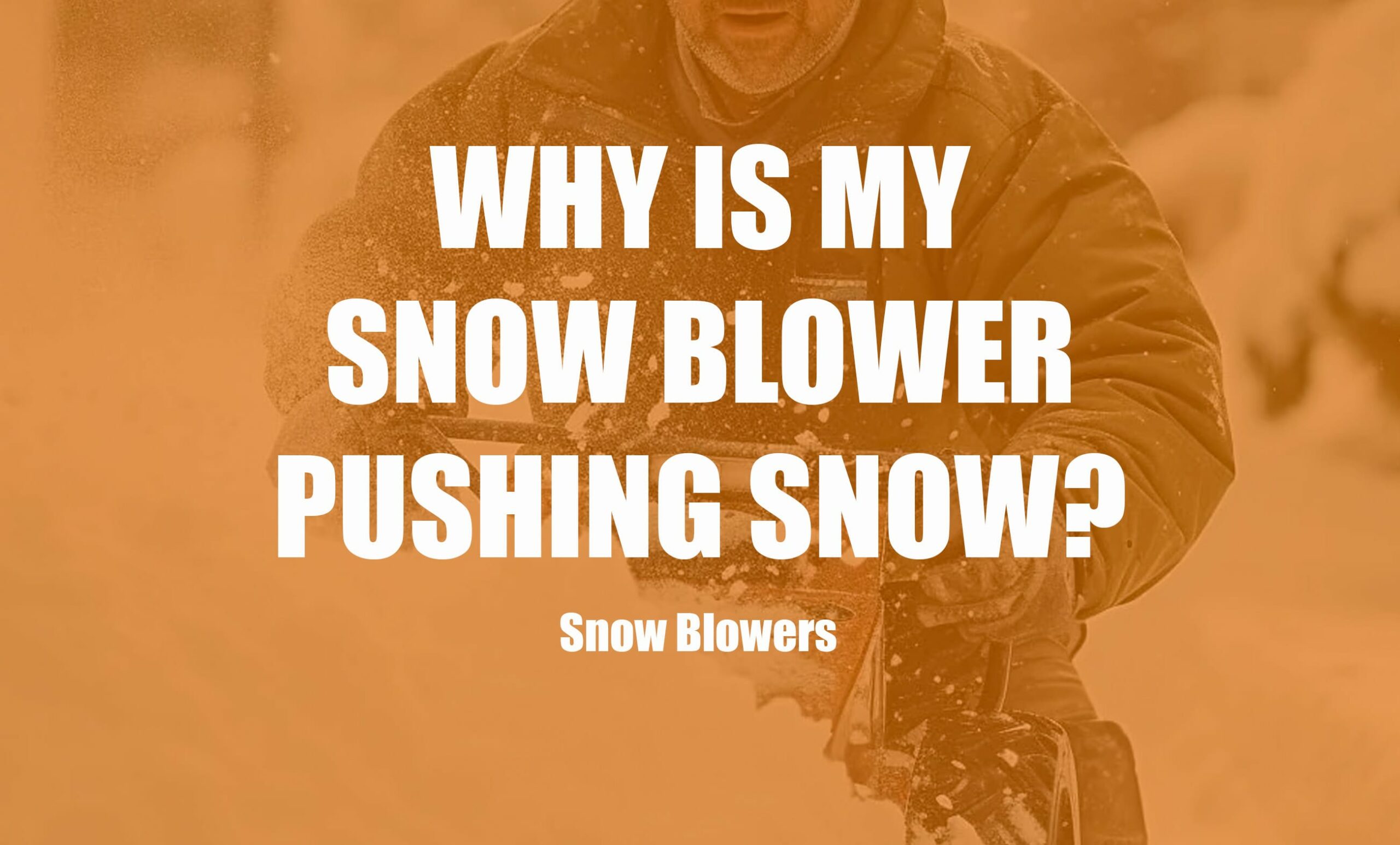Snow blowers are the unsung heroes of winter, tirelessly working to clear paths and driveways, making our lives a little easier.
But what happens when this essential tool starts pushing snow instead of throwing it? It’s a question that plagues many homeowners, leaving them frustrated and cold.
Understanding the mechanics of a snow blower and the reasons behind this common issue is the first step towards a solution.
So, in this comprehensive guide, I’ll delve into the world of snow blowers, exploring their functionality, common problems (i.e. why is your snow blower not throwing snow?), and expert solutions.
Let’s get into it
Understanding Snow Blowers & How They Blow Snow

Snow blowers are designed to make our lives easier during the snowy season.
But how do they work, and what makes them so effective?
Single-Stage Snow Blowers
Single-stage snow blowers are designed to grab the snow off the ground and throw it through the discharge chute in one step.
The scraper bar and paddles work in unison to scrape down to the surface, grab the snow, and throw it up and out of the chute.
These machines are partially propelled by the paddles, making them easier to push. They are more likely to grab heavy, compacted snow, making them suitable for areas with wet, heavy snowfall.
Thus, they are ideal for residential use, especially in regions that experience regular heavy snowfall.
Two-Stage Snow Blowers
Two-stage snow blowers have a rotating auger that breaks down and chews up snow and ice, and the impeller throws the snow up and out of the discharge chute.
Skid shoes allow it to glide across snow instead of dragging across surfaces.
Two-stage units don’t scrape as close to the surface, meaning they don’t typically grab as much compacted snow and tend to clog less frequently. They are more powerful and can handle deeper snow.
So, they are suitable for commercial use or homeowners with larger areas to clear as they are designed to handle more substantial snowfall and tougher conditions.
Why Is My Snow Blower Pushing Snow Instead Of Throwing It?

What happens when your snow blower starts pushing snow instead of throwing it? It’s a frustrating problem that many snow blower owners have faced.
Let’s dive into the reasons behind this issue and explore actionable solutions to get your snow blower back in action.
Clogged Chute
A common culprit behind snow blowers pushing snow is a clogged chute.
Snow and ice can easily build up, blocking the chute and preventing the snow from being thrown out.
To fix this, shut off the snow blower and clear the chute using an ice scraper tool. Applying a snow repellent like snow wax can also prevent future buildup.
And, regular lubrication of the moving parts is essential to prevent rusting and wear out. It’s a simple fix that can make a world of difference in your snow clearing experience.
Wet Snow
Wet snow is 2-3 times heavier than dry snow, and if your snow blower lacks power, it may struggle to throw it.
If upgrading is not an option, move slowly and reduce the amount of snow intake to avoid clogging. It’s all about finding the right balance and working with what you have.
And if updating IS an option, then I’d say a 2 or 3 stage blower is generally more suitable for heavy snow. Investing in the right machine for your needs can save you time and frustration in the long run.
Worn Out Auger Blade
The auger is responsible for cutting snow into manageable chunks. So, it’s easy to see how a worn-out auger can cause the snow blower to push snow instead of throwing it.
In fact, wet and icy snow can wear out the auger quickly, especially in underpowered snow blowers.
The best way to prevent this is by doing some regular oiling and maintenance of the auger blade to prolong its life. A little care and attention can keep your auger working efficiently and extend the life of your snow blower.
Damaged Gearbox and Broken Shear Pins
A damaged gearbox in a 2-stage snow blower can lead to the machine pushing snow.
If you’re not a mechanic or you’re not willing to take the snow blower to one, then I’d say to check for sufficient oil in the gearbox and look out for leaks.
Sadly, heavy damage may require a new gearbox. Broken shear pins, which link the auger to its drive mechanism, can also cause this issue.
If the auger stops working or moves freely with the blower turned off, the shear pins might be damaged.
You can consult your owner’s manual for the exact replacement. Understanding these components and how they work can empower you to diagnose and fix problems on your own, saving you money and time.
Tips For Using Snow Blowers

Let’s go over some tips and tricks to make sure you’re using that snow blower properly.
Trust me, it’s not rocket science, but a little guidance never hurts, right?
Know Your Snow Blower
First things first, get to know your snow blower.
Knowing your machine inside and out will make your snow clearing experience much more efficient.
I mean: Is it a single-stage, dual-stage, or triple-stage?
Understanding what you’re working with helps you handle different types of snow. Just check the manual, and you’ll be good to go.
For instance, a single-stage snow blower is best suited for light to moderate snowfall. It’s perfect for clearing sidewalks, decks, and small driveways.
If you’re dealing with heavy, wet snow, you might want a 2 or 3 stage blower as these machines are more powerful and can handle the tough stuff, including icy patches and larger areas.
Clearing the Chute
Clogged chute? No biggie.
Just turn off the snow blower, grab an ice scraper tool, and clear that chute. You can even spray it with some snow repellent to keep things smooth.
Remember, safety first, so make sure the machine is off before you poke around.
And don’t just clear the chute; make sure to check other parts of the machine for ice and snow build-up.
Pro tip: Regular checks and cleaning will keep your snow blower running smoothly and prevent any unexpected surprises. It’s like keeping your room clean; a little effort goes a long way.
Power and Pace
Wet snow can be a pain, and if your snow blower isn’t powerful enough, you might struggle.
If you’re not ready to upgrade, just take it slow.
Reduce the amount of snow you’re taking in, and you’ll avoid clogging.
I mean, I believe it’s like driving in the snow; sometimes, slow and steady wins the race. Don’t be afraid to adjust your pace and approach based on the type of snow you’re dealing with.
Wet snow requires more care and patience, while dry snow can be handled more quickly.
Maintenance and Care
Your snow blower is like your car; it needs some TLC.
Regularly oil the auger blade, check the gearbox, and replace any broken shear pins.
Don’t forget to check the tires, belts, and other moving parts. Regular maintenance checks will help you spot any potential issues before they become big problems.
After each use, clean it up and store it properly. A little care goes a long way in making sure your snow blower is always ready for action.
Think of it as regular check-ups at the doctor; preventative care is always better than dealing with a breakdown.
Best Snow Blower Overall
Snow Joe SJ627E Electric Snow Blower
I was impressed by how effortlessly it handled different types of snow, from light and fluffy to wet and heavy.
With a powerful 15-amp electric motor, it moves up to 25 tons/hr of snow and clears a 22-inch x 13-inch path in a single pass.
Equipped with 2 x 15 W LED lights, nighttime snow removal is no longer a hassle.
Also, the all-steel auger cuts a 22-inch wide by 13-inch deep path with each pass, making it efficient and effective.
The 180-degree adjustable chute gives you the option to throw snow up to 25 feet wherever you’d like which allowed me to direct the snow exactly where I wanted it, keeping my driveway and walkways clear and safe.
Another big feature to mention is their compact wheels for easy maneuverability in winter-weather conditions and a chute cleanout tool to remove snow buildup.
Pros
- Ideal for various snow conditions and areas.
- 15-amp motor moves up to 25 tons of snow per hour.
- LED lights that acilitate nighttime snow removal.
- Adjustable chute that directs snow up to 25 feet away.
- All-Steel Auger that cuts a 22-inch wide path with each pass.
Cons
- Not for wet snow
Frequently Asked Questions
Why won’t my snowblower throw heavy snow?
If your snow blower is struggling like mine did, you might want to check the auger.
If it’s worn out, it won’t cut through the snow effectively. You can also try reducing the amount of snow intake to avoid clogging. And if all else fails, upgrading to a 2 or 3 stage blower might be the way to go. It made a world of difference for me.
How do I make my snowblower throw more snow?
I found that keeping the chute clear and regularly maintaining the auger really helped. Applying snow repellent like snow wax also prevented buildup and improved efficiency. It’s like giving your snow blower a little boost!
How do I fix my snowblower from sputtering?
When my snow blower started sputtering, I first checked the fuel and replaced it with fresh fuel. Then I cleaned the carburetor, and that seemed to do the trick. If you’re still having trouble, inspect the spark plug. A faulty one can cause sputtering, and replacing it might solve the problem.

